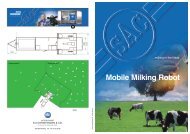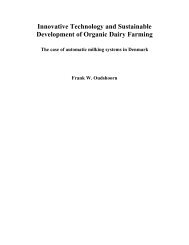Validation of Calibration Equations Developed ... - Automatic Milking
Validation of Calibration Equations Developed ... - Automatic Milking
Validation of Calibration Equations Developed ... - Automatic Milking
You also want an ePaper? Increase the reach of your titles
YUMPU automatically turns print PDFs into web optimized ePapers that Google loves.
1 Introduction<br />
Feed is one <strong>of</strong> the major costs in dairy production. It constitutes as much as 84% <strong>of</strong> the<br />
variable costs in conventional farming in Denmark and 88% <strong>of</strong> the variable costs in organic<br />
farming (Andersen & Due 2010). Optimization <strong>of</strong> the feed plans is one way to keep the costs<br />
down and incomes up. Optimization requires knowledge about the dairy cows’ nutritive<br />
needs and the nutritive content <strong>of</strong> the feeds. Grazing is by many suggested as a cheap source<br />
<strong>of</strong> roughage but it imposes several challenges. The herbage mass at the pasture can not be<br />
weighed before or after feeding, as other feeds can, which makes optimization <strong>of</strong> the feed<br />
plan difficult. Utilization <strong>of</strong> grazing as part <strong>of</strong> the feeding regime requires estimates <strong>of</strong> the<br />
herbage mass at the pasture and estimates <strong>of</strong> amount herbage mass ingested by the dairy<br />
cows in order to optimize the supplement feeding. These estimates can be obtained by a<br />
number <strong>of</strong> different prediction methods which all require calibration <strong>of</strong> the prediction<br />
equations, for a review see Lopez Diaz & Gonzalez-Rodriguez (2003). Sanderson et al. (2001)<br />
reported that the precision <strong>of</strong> the estimates <strong>of</strong> pasture yield should be minimum ±10% <strong>of</strong><br />
the actual yield in order for forage budgeting to increase net returns. A lower precision<br />
would not justify the investments required by the farmer.<br />
Measures <strong>of</strong> sward height are used in many prediction methods to estimate pasture yield.<br />
Sward measurements can also be used to control the sward state and thereby the quality <strong>of</strong><br />
the herbage mass. The relationship between sward height and yield is established since long<br />
(Robel et al. 1970; Davies et al. 1989) and the measurement equipment is diverse. A<br />
relatively new method is the C-Dax Pasture Meter® (CPM) which has a measuring system<br />
based on infrared light beams. The measurement equipment is <strong>of</strong> such size that is needs to<br />
be towed by a vehicle, e.g. an all terrain vehicle (ATV).<br />
1.1 Problem statement<br />
In the master thesis “Herbage Dry Matter Mass <strong>of</strong> Pastures Estimated through Measures <strong>of</strong><br />
Sward Height” (Hansson 2011) was the C-Dax Pasture Meter® (CPM) calibrated under Danish<br />
conditions. New calibration equations were developed and the coefficient <strong>of</strong> determination<br />
(r 2 ) was between 0.63 and 0.89. The r 2 reported indicated that over half <strong>of</strong> the variation in<br />
the data is accounted for in the model and the confidence intervals indicated that the model<br />
4




